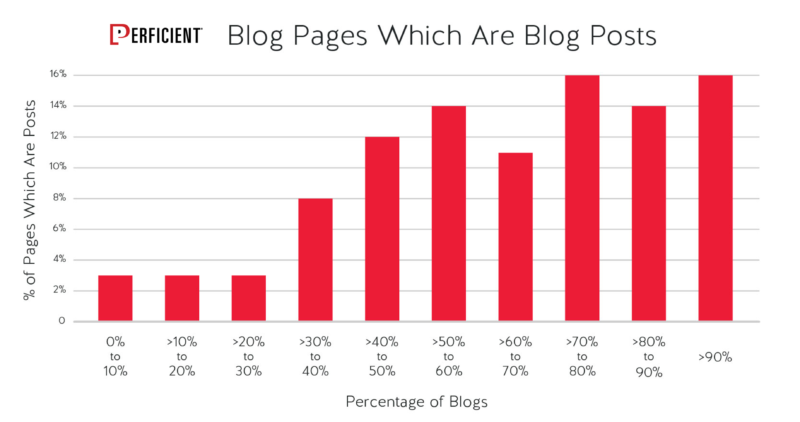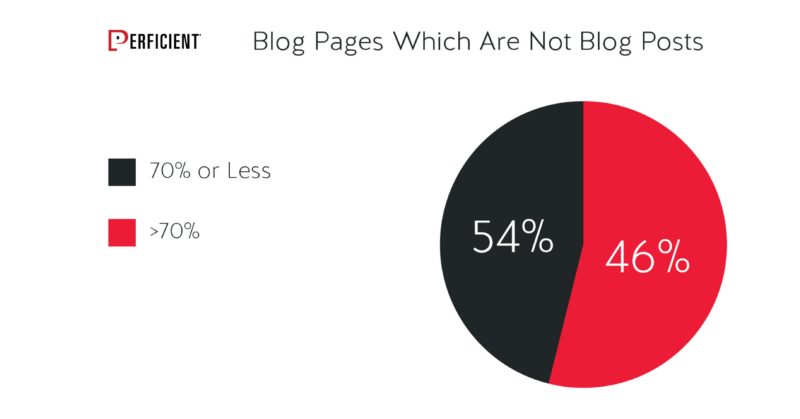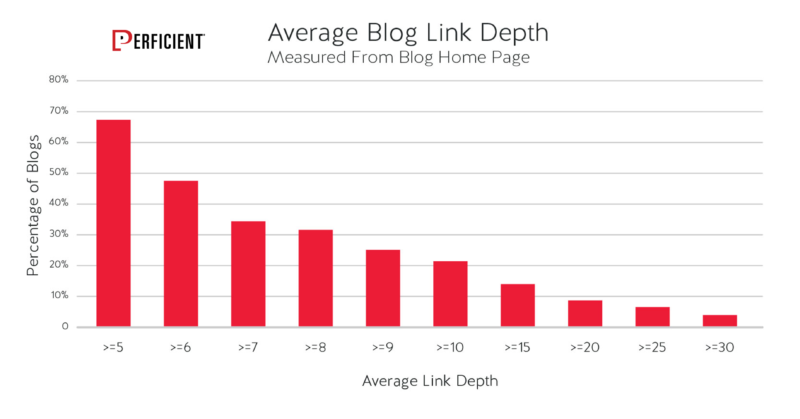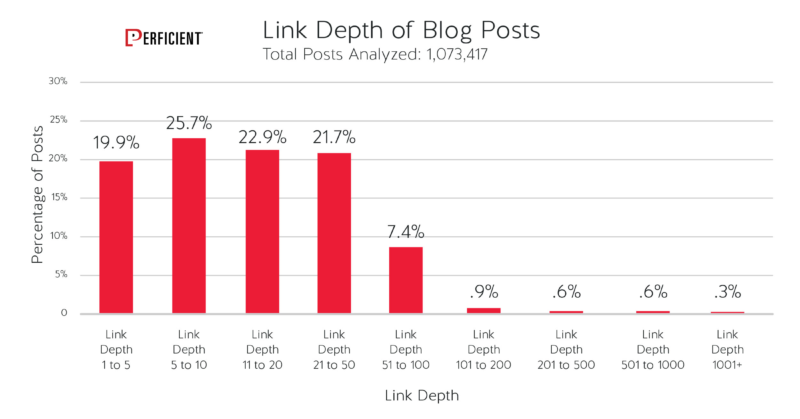We started with the theory that blogs are used as publishing platforms on many sites where they don’t make sense. The reason for this theory is that the majority of content published in blogs is evergreen content – and that two main components of a blog don’t work well with evergreen content. These components are:
- The site structure of a blog contains a lot of “overhead” pages that don’t make good targets for indexation and ranking by Google, such as category pages, paginated pages, tag pages, and date archives. This is counterproductive, as it results in Google having to crawl through pages that contain no SEO value, rather than focusing on pages that do.
- Blog posts “age” over time. What this means is that, as newer content is published, these posts become more distant (in terms of clicks) from the blog home page. This does not make sense for evergreen content, as its value may not age; thus, its placement in a site hierarchy shouldn’t be dependent upon the age of the post, but should be dependent upon the post’s current value.
To investigate just how much of an issue these concerns are, we conducted a study of 100 randomly selected blogs. We took each of these blogs and crawled every page from top to bottom, so we could fully map out their structure and the content on them.
Blog Structure Study Results
The first area we examined is whether or not the structure of a blog is fundamentally flawed. To do this, we evaluated what percentage of the pages in a blog were blog posts vs. other types of “overhead” pages. This is what we found:
 We can also present that data a little differently by focusing on the percentage of pages that are NOT posts:
We can also present that data a little differently by focusing on the percentage of pages that are NOT posts:
 What we see is that more than half of the blogs studied contained 70% or more pages that were not blog posts. In fact, only 29% of the blogs we looked at contained 50% or more pages that were blog posts. This is significant, as category pages or tag pages whose only content is links to posts, posts or post extracts are not likely to rank in search engines.
What we see is that more than half of the blogs studied contained 70% or more pages that were not blog posts. In fact, only 29% of the blogs we looked at contained 50% or more pages that were blog posts. This is significant, as category pages or tag pages whose only content is links to posts, posts or post extracts are not likely to rank in search engines.
We also found many other types of pages that held very low value and had very little potential for ranking, such as paginated pages and comment pages.
The data for link depth is equally interesting. This is the data for the average link depth of posts across the 100 blogs we sampled:
 A stunning two-thirds of the blogs had an average link depth greater than 5 (where link depth means the number of clicks from the home page of the blog to the content). The problem is, content that many clicks away from the blog’s home page (a link depth of 6 clicks or more) is unlikely to rank for anything unless it has earned external links.
A stunning two-thirds of the blogs had an average link depth greater than 5 (where link depth means the number of clicks from the home page of the blog to the content). The problem is, content that many clicks away from the blog’s home page (a link depth of 6 clicks or more) is unlikely to rank for anything unless it has earned external links.
Looking at this data from the perspective of the distribution of the link depth across all the posts, the results are as follows:
 That’s fascinating to see. In some cases, the posts were more than 1,000 clicks away from the home pages – we discovered 3,488 posts in our sampling that were buried that deeply in the overall site hierarchy. In fact, 31.5% of the posts we found were 21 clicks or more from the blogs’ home pages, and 9.5% were 50 or more clicks away.
That’s fascinating to see. In some cases, the posts were more than 1,000 clicks away from the home pages – we discovered 3,488 posts in our sampling that were buried that deeply in the overall site hierarchy. In fact, 31.5% of the posts we found were 21 clicks or more from the blogs’ home pages, and 9.5% were 50 or more clicks away.
Summary
We did find examples of blogs that were very well structured. These examples contained very little waste in the site hierarchy and did not show excessive link depth. What this tells us is that it’s possible to configure blogs in a way that works well, without large quantities of crawlable pages that offer no value to the Google index.
A bigger issue to address is that blogs are inherently temporal in nature. For example, over time, a post’s placement in the blog hierarchy ages in a manner that is solely determined by the mechanics of the blog. The result is that it falls further and further away from the blog’s home page over time. For evergreen content, this makes no sense. A post’s placement on your site is something you will want to control more directly.
Of course, some blogs are very news-oriented. They publish content that is temporal in nature. We evaluated our 100 test blogs and determined that 92% percent of the posts examined were evergreen in nature as opposed to temporal. This shows that a large percentage of the blogs reviewed were primarily publishing content that would likely yield better results by being published outside of a blog.
Building out your own content hub (instead of a blog) is what we recommend for such sites. This will allow you to manually control the placement of the content on your site and ensure that the content of most value to your site’s users appears near the top of your site hierarchy.
This is the approach we recommend for sites investing heavily in content, as it will help to gain the best results from that investment.


Great article! I had never really thought about how link depth and blog structure could play such key roles in how blog posts rank. Just wondering then, how would you define a “content hub”?
Hey Eric,
Great article, all makes sense. But perhaps I’m missing something fundamental as it seems a very simple matter (in WordPress) to place all posts or pages within 5 links.
Since it’s this easy, am I misunderstanding something or are others simply not aware of the “5 link depth” importance?
Thanks,
Tom Malcolm
I have Amazon affiliate blog with 45+ posts and most of them have 5 to 6 thousand words and 3 to 4 have 10000 words.
I want to know that can I show all posts on home page?
Because in post excerpt it don’t have images so loading speed will not be increased. Then all of my posts will be one click away from users and search engines.
I agree with Tom Malcolm – isnt the default link depth for more blog posts usually between 2-5 clicks away from the homepage? I’m not sure how a page could even have a link depth of more than 5 or 6…
It’s been a while since anyone talked about posts and pages. When I started using wordpress I leveraged the power of categories but apparently they are of little use for Google nowadays. I still believe there are ways of making categories work.
Hi Tom – Basically, it relates to how many posts can go on an archive page prior to the post falling into pagination. But eventually, pagination occurs. In addition, another factor is how often you post too, of course. For high volume blogs the descent down the click depth table can be relatively fast.
Regardless though, I personally think that it’s far smarter to retain manual control over click depth. You may have a brand new post that you want to start at a click depth of 5, and a 5 year old post that you want at click depth 2. With a content hub you can easily do that.
Hi Sol – please note the response I provided to Tom below.
Hi Ali – you can certainly link to some of them from the home page, but it’s unlikely you’d want to link to them all from there. Surely they’re not all equally important? You might want to take the 10 most important ones and link to them from the home page, and have the others one click further down in the hierarchy.
Hi Molly – a content hub would be a section of your site that you use to publish your informational content. Rather than using a blog, you’d manually control the link depth of your content. You can actually build one of these in WordPress using the Pages approach to publishing content.
Hey Tom- sorry for the slow response, but I missed this one. Yes, a lot of people put their blogs out there without thinking about this at all. They simply publish them and think they’re more or less done.
This article needed to be written – doing things the same way without paying attention to details is just crazy – I see this type of lax implantation all the time when doing audits.
The “new” thing is topic clustering it helps a lot! You cannot just add blog content but now must have that topic cluster.